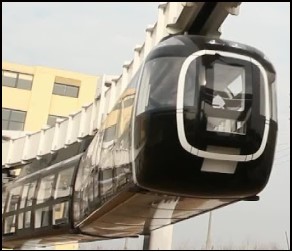Elevated Metro Proposals
This has the advantage of not disrupting Melbourne's heavily congested rail and light rail systems with additional traffic.
The automated Skyrail trains are able to affordably operate all day every day with services each two or three minutes.
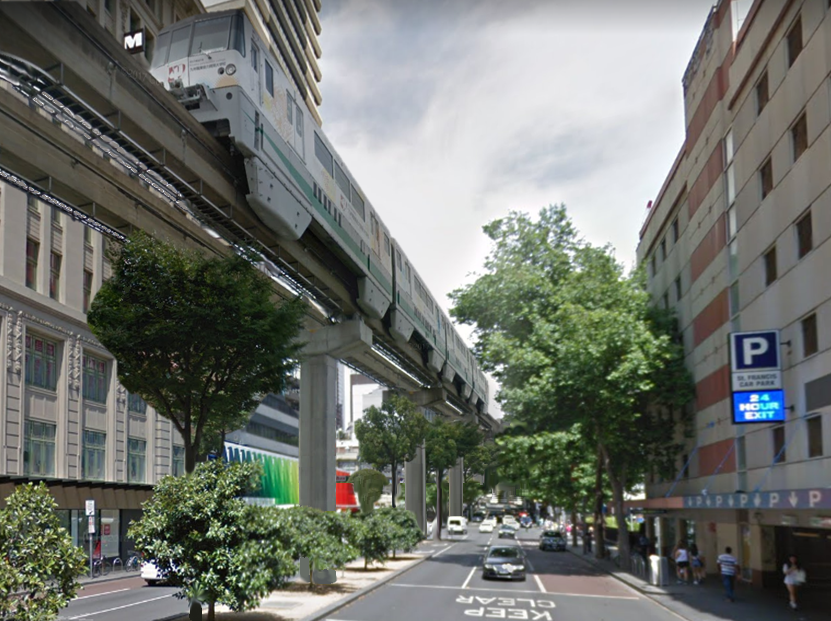 What about an Elevated Metro 2? Image shows a Hitachi 'Large' train above Lonsdale Street, Melbourne. |
The Proposed System
This would probably use the straddle-beam "ALWEG" type of monorail train that are suited to systems that need a station every few kilometres. They have a top speed of around 80km/h and a capacity of about 100 persons per carriage.
Initially three-carriage trains could be used with a view to extending to eight carriages over time.
Over time a substantial network of monorails could be built up to complement the existing tram and train networks.
|
Overview of the Skyrail monorail lines with proposed stations.
|
Skyrail segments could be built independently and expanded as needed. The Airport - CBD segment is suggested as a first step.
- Airport Monorail: A 20 km monorail linking Southern Cross Station to the Airport in under 20 minutes at far lower cost than any of the proposed heavy-rail options. See the Airport Monorail Page.
- Chadstone Monorail: A 15 km monorail linking Southern Cross Station to Chadstone Shopping Centre. See the Chadstone Monorail Page.
- West Monorails: Monorails to Highpoint and Point Cook from Southern Cross Station. An alternative route to the Airport. See the West Monorails Page.
- Doncaster Monorail: This 18 km monorail provides the long-awaited high-capacity public transport link to Doncaster to Southern Cross Station. Unlike the Doncaster heavy-rail link it leaves the Clifton Hill rail lines alone allowing more trains to be scheduled on that line as required. See the Doncaster Monorail Page.
- Chadstone Monorail Project: An 11 km monorail linking Ashburton, Holmesglen, Chadstone, Oakleigh and ultimately Monash University. This creates a north-south link between Melbourne's major eastern rail lines. See the Chadstone Monorail Project Page.
- Fishermans Bend Monorail: This short line could connect the new high-rise developments proposed for this area to Southern Cross railway station and the CBD. We have not planned this any further as details of this development are still unknown.
- La Trobe Uni Monorail: A short monorail link from Macleod Station to La Trobe University is being examined. This could run as far west as Reservoir station via Summerhill Shopping Centre if desired.
All these systems would use a common design allowing sharing of rolling stock and easy interconnection.
Monorail Advantages
|
The fully automated Bombardier Innovia. (vimeo.com/65368766) |
Extending the rail or tram networks is difficult and expensive since this inevitably means placing more strain on systems that are struggling with existing passenger loads.
- Full Independence Skyrail would operate completely independently of all other transit systems.
- Cost Effective At around $50 million per kilometre monorails are one of the most cost-effective grade separated transit solutions available where there is no space left at ground level.
- No Rail Disruption Extending a Doncaster rail line from the Clifton Hill line would seriously reduce maximum service levels to South Morang & Hurstbridge. Skyrail allows interchange but does not disrupt Clifton Hill rail services.
- Affordable all day operation As monorails can be automated minimal staff are needed overnight allowing the system to remain open to selected customers. (The system would probably need to close for an hour early in the morning to allow for any guide way maintenance.)
Monorails vs. Trams and Trains.pdf.
The $2 per week rate levy
Fortunately monorails are cheap enough to be able to be funded by a small rate levy.
Given current low interest rates, a 20 year term. A rate levy of about $2 per week on Melbourne's 1.6 million households would cover the repayments for a loan of $3 billion dollars for these three monorails routes. A slightly higher amount would cover the operating costs meaning residents of participating municipalities would travel for free for most trips.
The rate levy would vary depending on the likely usage of the system by the rate-payers.
Use the calculator below to determine the cost per week for each benefitting household.
| Skyrail component | Approximate Cost ($M) |
| Airport Monorail | 1,000 |
| Chadstone Monorail | 750 |
| Highpoint Monorail | 450 |
| Doncaster Monorail | 900 |
| Ashburton - Monash Monorail | 600 |
| Total | 3,700 |
Note that there are no mandatory components but a depot, control rooms and stabling yards would be needed somewhere.
This script provided by JavaScript Kit
More detailed cost estimates cannot be obtained without an 'expression of interest' from a State government or opposition. The above just indicates that the concept appears to be feasible.
Straddle Beam or Suspended?
Either type could be used depending on cost and preference.
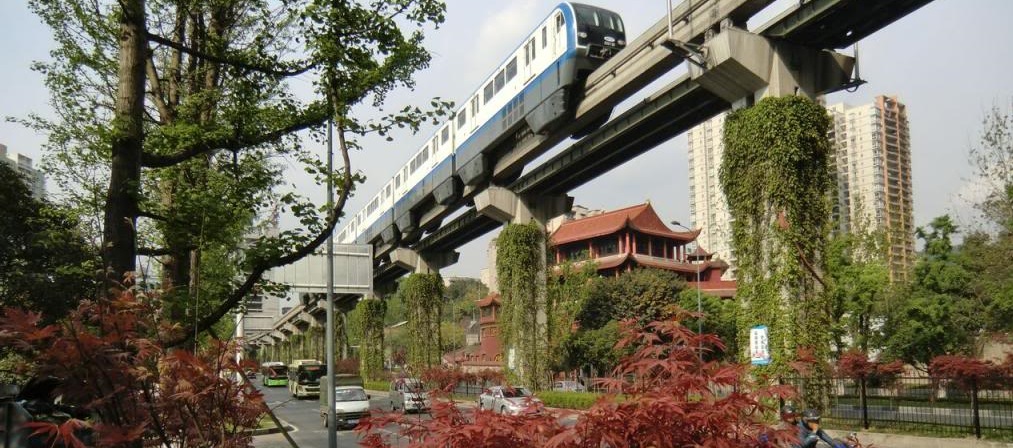 Part of the 75 km Chongqing Monorail in China by Hitachi (Skyscraper City). |
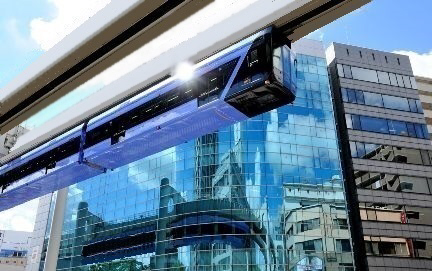 Mitsubishi Flyer in Chiba, Japan. This image has been adjusted to show a three-car train and how the guide-way would appear with cosmetic outer panelling similar to what is used on the Shonan monorail. See also here.) |
Demand & Capacity
Skyrail offers enough capacity to service all Melbourne Airport - CBD passenger traffic and have ample capacity left over for suburban travellers from Airport West and Essendon as well.
- Melbourne Airport has about 30 million passenger movements per year increasing by 2 million per year. (See Melbourne Airport Statistics.)
- In addition to passengers there are 14,000 people employed at the airport and also people seeing off or greeting passengers.
- If this is rounded off as 100,000 per day we get a figure of about 5,500 an hour assuming most movement is in a 18 hour day. (The airport never actually closes.)
- From the capacity table we see that Skyrail could easily handle 100% of this loading with a 4-car train every 4 minutes. Monorail trains can be up to 8 carriages and can run 90 seconds apart.
In reality many Airport workers and users will not want to go to a destination on the Skyrail network so the system could reasonably be built with 2 or 3 carriage trains running every 3 or 4 minutes to start with. Trains and services can then be expanded as needed.
In addition to airport users and commuters we would expect some people to use the Skyrail purely as a tourist attraction in its own right. This could comprise 5 to 10% of the passenger load especially when it first opens.
Operation and staffing
|
The fully automated Bombardier Innovia. (vimeo.com/65368766) |
Skyrail trains would be automated and operate every two to three minutes without a public timetable.
At most times trains would have a crew of one attendant to provide security and assistance to passengers and for safety reasons.
Stations would be staffed for standard operating hours with the emphasis on preventing vandalism and fare-evasion. Cleaners would operate on trains and stations around the clock providing an additional presence.
Two or more secure control rooms would be capable of operating the entire system remotely.
Ticketing
The Myki ticket system that is used for most other public transport in Melbourne could be used for the Skyrail system.
A wide range of other ticketing systems are also available that should be considered to see if they offer cost savings or functional advantages over Myki. Most monorail vendors offer ticketing solutions as part of their offering.
The selected ticket system must provide a strong automated barrier to fare-evasion. It is essential that anonymous entry to the system is prevented through forced use of credit cards or direct debit to pay for tickets as a means of reducing vandalism and anti-social behaviour. This allows trains to have a quality interior and still be available all day.
Skyrail train interior design
All monorail train vendors considered for Skyrail offer train carriages that have a flat floor and are about three meters wide which is similar to the width of heavy-rail train carriages. This means that any seating arrangement suitable for V/Line or Metro trains could be used on Skyrail trains.
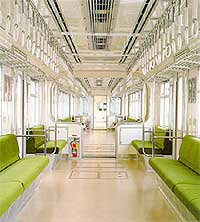 |
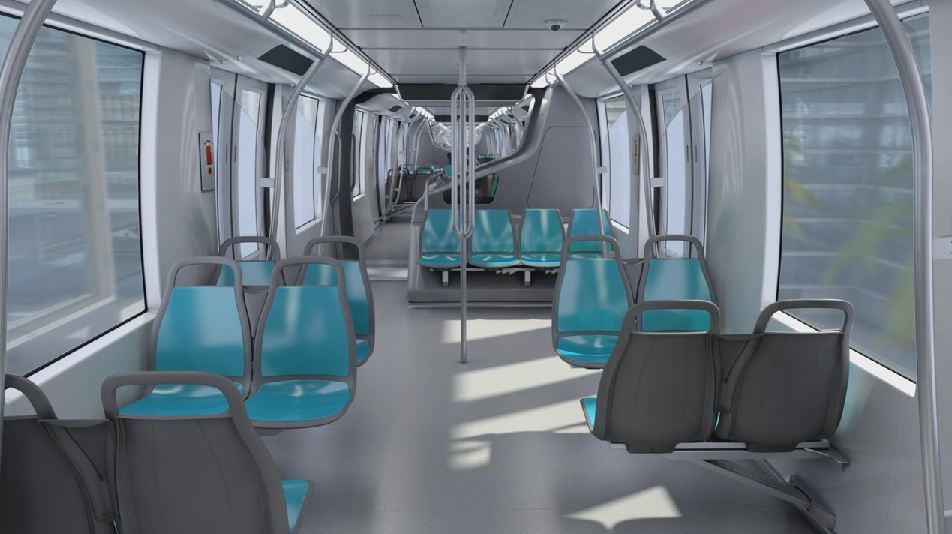
|
| Hitachi train with seating along the sides (Hitachi) | Bombardier Innovia 300 2 by 2 seating option. (vimeo.com/65368766) |
Our preference is for seating that allows passengers to look out the window seeing as the view will be excellent.
Quality interior
Skyrail trains should have a quality interior with heavy-duty carpet used on the floors and comfortable seats. Carpet provides a quality non-slip floor, improved sound deadening and affords some protection for passengers who fall in the train.
Note that due to their elevation all Skyrail stations have to be fully enclosed to protect passengers from the elements. This means the trains are also protected so the carpet should not get wet. Strong ticket barriers to the system, prevention of anonymous entry and staffing of the trains protect the system from vandalism.
Stations
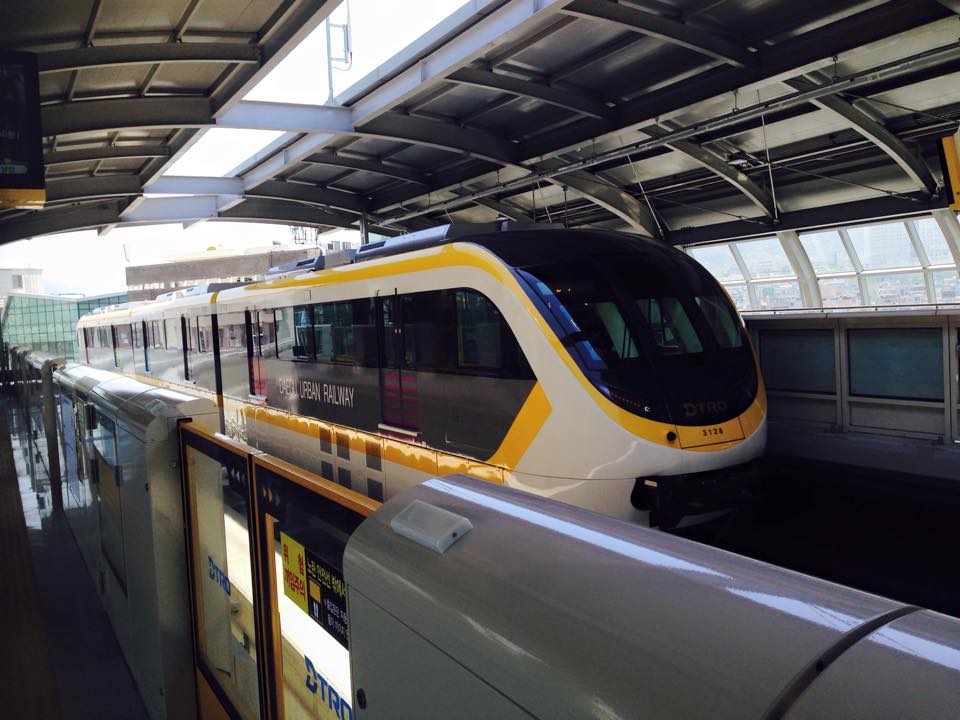 Monorails take up very little space and cost a fraction of what a subway would cost. (Daegu Monorail, South Korea. Wikipedia) |
Stations would be built to a standard design allowing for mass production of components. All stations are enclosed with platform screen doors. Escalators and lifts to the platforms are provided. At ground level bus and/or tram interchange is provided as well as bike lockers and taxi ranks.
Safety
See our safety section.
